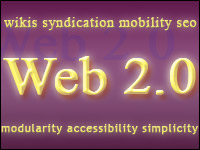
It’s clear the way we work is rapidly changing. Organizations and teams are becoming more geographically dispersed with the increased globalization of business. Networks of employees, partners, and customers are spanning the globe as industry becomes more interdependent.
This means information exchange must keep pace as organizations facilitate search and discovery of all manner of content, including digital documents, images, videos and, increasingly, social information.
Enterprise 2.0 (E2.0) can help organizations link content, knowledge and collective input to make corporate communities more productive, effective and agile. It is comprised of tools and business practices that let organizations cost-effectively share knowledge, collaborate, and bring an organization’s collective (or social) intelligence together to solve problems.
Despite these benefits, many organizations are struggling to adopt the E2.0 mentality. The knowledge management industry has focused on two majors reasons for this. One, organizations lack understanding about the technologies driving E2.0. And two, cultural norms and complacency are preventing organizations from “doing business differently.”
Social Collaboration
Having technology that supports social collaboration, as well as a culture that embraces it, are equal and necessary requirements to a successful E2.0 initiative. For instance, some companies might be open to cultural diversity and change, which can help E2.0 flourish. However, the company also needs the appropriate technology so that it can take advantage of that culture and use it to realize business benefits.
The E2.0 technologies that get it right will be chameleon-like in their ability to fit into any organization’s structure and culture. These technologies will also be customizable, as companies figure out the right balance of social for their enterprise. Companies should be able to control how content, knowledge, and collective input is connected and used.
One such system designed to meet these requirements is a social knowledge network (SKN). Empowering the broader organization to contribute to its knowledge base, as well as putting tools in place to ensure knowledge is properly vetted and managed, are the keys to creating a true SKN.
As with traditional knowledge management systems, SKNs also collect and organize most any data — documents, presentations, photos, videos, audio recordings, etc. This information forms the basis of an organization’s core knowledge base.
The difference is that SKNs take it one step further by adding social tools — such as blogs, wikis, online ratings, discussions, and social tags — to tap the collective wisdom of the entire corporate community. This can include all of its locations around the globe.
SKNs provide a way to unleash wisdom so employees can share knowledge and update and enrich core content. This creates a dynamic, living knowledge base, where employees can access reliable information and enhance the value of the knowledge base.
Perhaps the best part is, compared to traditional knowledge management systems, an SKN avoids the need for business process re-engineering because it utilizes Web 2.0 concepts to gather and capture knowledge. An SKN also has security features that enable control over what, when and how contributions are made. This avoids the information veracity problems that are typical with traditional social media.
Managing an SKN
To see how an organization would use an SKN, consider a scientist in a pharmaceutical company conducting later-stage clinical trial testing. She can use the SKN to quickly access a report completed by a fellow scientist that describes the side-effects of the drug in a section of the population that’s prone to a certain interaction or side-effect.
Not only does her research benefit from having all relevant information accessible in a single repository, but user ratings, comments, and social tags from her colleagues further inform her insight and understanding of the information.
SKNs let organizations move to a new two-way (Web 2.0) paradigm regarding enterprise knowledge management, where information can be strengthened and acted upon. They can also address some primary cultural barriers to E2.0.
For instance, many organizations are accustomed to having boundaries prescribing who should work with whom, and processes dictating specific business practices. They might perceive E2.0 as a threat to its control over its knowledge assets and content veracity.
SKNs, however, can be customized and adjusted to address these concerns. SKNs are managed by a designated administrator, a role ideally suited for corporate librarians or knowledge professionals. They control what, when and how contributions are made to the SKN using a “social volume knob.” This comprises security tools that let the administrator adjust who has what access and which contribution rights.
Adjusting the Volume
When an organization rolls out an SKN, it might want to start with the volume knob set “low” for certain employees. This indicates employees have fewer capabilities. For instance, some employees might be allowed to tag one type of content, while others can blog or comment on content.
A “high” setting on the social volume knob, on the other hand, would give employees more freedom and capabilities. This is usually provided to domain and subject-matter experts, who can be authorized to write and edit content, and have access to full social capabilities.
And then there is everything in between, depending on each organization’s security requirements and comfort levels. Each contributor’s access capabilities can be adjusted, so perhaps one employee can blog, rate and comment, while another can just comment, and only on certain content. Authorized employees, such as subject-matter experts or executive librarians, can edit or delete erroneous or misguided social commentary. This lets vetted information retain its veracity, context and relevancy.
Security features of the social volume knob also provide reports and statistics on social use, so the administrator can identify when the system is being misused. Because employees are logged in, there can be no gaming of ratings — each employee gets one vote.
A social volume knob allows employees to work within the constraints of their organization’s culture and processes, and allows organizations to retain their cultural values and practices. Unmanaged social knowledge networking naturally risks culture shock, as well as information chaos that can destroy an SKN initiative. By implementing an SKN in a controlled, content-centric manner, organizations are able to preserve the integrity of the workflow or the knowledge repository.
Enterprise 2.0 is developing in response to demand for effective ways to support information sharing, teaming and collaboration. Organizations are looking for secure, flexible environments where employees can add, organize, share and socialize information. Social knowledge networks are ideally suited to improve search and discovery, increase knowledge transfer, and improve organizational agility.
Phil Green is the chief technology officer and a bloggerfor Inmagic.













































Social Media
See all Social Media